Aeolian Landscapes and Paleoclimatic Legacy in the Southern Chacopampean Plain, Argentina
Abstract
1. Introduction
2. Materials and Methods
2.1. Study Area and Regional Geology
2.2. Methodology
2.2.1. Remote Sensing and Geomorphological Mapping
2.2.2. Chronometric and Sedimentological Framework
3. Results: Geomorphological Environments
3.1. Corridors, Crest, and Playas
3.1.1. The Southern Depression
3.1.2. Longitudinal Crests and Corridors
3.2. Longitudinal Dunes and Parabolic Dunes: The Pampean Sand Sea
3.2.1. Longitudinal Dunes
3.2.2. Parabolic Dunes
3.3. Playas and Lunnetes
3.4. Mantiform Loess and Transverse Silt Dunes
4. Discussion
4.1. Paleoclimatic Influence and Eolian Processes
4.2. Exogenous Processes as Drivers of Furrow Formation
4.3. Orientation and Evolution of Aeolian Furrows and Deflation Landforms
4.4. Implications for Land Use and Environmental Management
5. Conclusions
- The longitudinal depressions to the east of La Pampa and the west of Buenos Aires are furrows primarily formed by aeolian action, with contributions from other geomorphological processes such as weathering, fluvial activity, and mass wasting. These landforms developed under climatic conditions more extreme than those of the present, in connection with global glacial events. Their origin reflects an evolutionary sequence that begins with karstic processes and continues with erosional mechanisms, mainly aeolian (deflation, abrasion), fluvial (ravine development), and slope-related. Aeolian processes may have initiated small depressions (dolines) through the dissolution of the carbonate layer that caps the regional sediments, while the other processes significantly contributed to their enlargement in the direction of prevailing winds, leading to their integration and the consolidation of the furrows.
- The orientation of the furrows reflects the directions of the winds in time and latitude, which is also reflected in the accumulation shapes, both of sand dunes and silt, generated by winds from the W and the S, covering the entire quadrant.
- Some of the sandy deposits of the Pampean Sand Sea, and the more distant loess deposits located, likely derive from the deflated material of the Cerro Azul Fm. from the furrows, mobilized under extreme climatic conditions.
- The longitudinal and parabolic dunes record the direction of prevailing winds, from the southern to the western quadrant. Their numerical ages indicate the time of formation and the continuity of these winds, from the Late Pleistocene to the Late Holocene, particularly in the central west of the study area.
- At the center and NE of Buenos Aires Province, the main features are the deflation basins and lunettes, mantiform loess, and silty transverse dunes, with winds coming from W and SW and ages ranging from the late Pleistocene to the Middle Holocene, indicating a sustained water deficit during most of this period.
- Beyond their geomorphological significance, these aeolian landscapes highlight the sensitivity of the landscape to climatic variability. Understanding their spatial distribution and evolution provides useful insights for identifying areas of potential environmental vulnerability and for guiding sustainable land management in comparable temperate plains.
Author Contributions
Funding
Data Availability Statement
Acknowledgments
Conflicts of Interest
References
- Groeber, P. Mineralogía y Geología. Espasa-Calpe: Buenos Aires, Argentina, 1938; 492p. [Google Scholar]
- Iriondo, M. Geomorfología y Cuaternario de la provincia Santa Fe (Argentina). D’Orbignyana Corrientes 1987, 4, 1–54. [Google Scholar]
- Pommarés, N.; Fucks, E.; Pisano, F.; Luengo, M.; Ramos, N.; Di Lello, C. Late Pleistocene-Holocene paleoenvironments in the middle basin of the Salado river, province of Buenos Aires, Argentina. J. S. Am. Earth Sci. 2021, 105. [Google Scholar] [CrossRef]
- Ramos, V.A. Las provincias geológicas del territorio argentino. Geol. Argent. 1999, 29, 41–96. [Google Scholar]
- Fucks, E.; Deschamps, C. Depósitos continentales cuaternarios en el noreste de la provincia de Buenos Aires. Rev. Asoc. Geológica Argent. 2008, 63, 326–343. [Google Scholar]
- Berger, A. Milankovitch theory and climate. Rev. Geophys. 1988, 26, 624–657. [Google Scholar] [CrossRef]
- Caldenius, C.C.Z. Las glaciaciones cuaternarias en la Patagonia y Tierra del Fuego: Una investigación regional, estratigráfica y geocronológica—Una comparación con la escala geocronológica sueca. Geogr. Ann. 1932, 14, 1–164. [Google Scholar] [CrossRef]
- Mercer, J. Cenozoic glaciation in the Southern Hemisphere. Annu. Rev. Earth Planet. Sci. 1983, 11, 99–132. [Google Scholar] [CrossRef]
- Meglioli, A. Glacial Geology of Southernmost Patagonia, the Strait of Magellan and Northern Tierra del Fuego. Ph.D. Thesis, Lehigh University, Bethlehem, PA, USA, 1992. [Google Scholar]
- Rabassa, J.; Coronato, A.; Salemme, M. Chronology of the Late Cenozoic Patagonian Glaciations and their correlation with biostratigraphic units of the Pampean Region (Argentina). J. S. Am. Earth Sci. 2005, 20, 81–103. [Google Scholar] [CrossRef]
- Clague, J.J.; Barendregt, R.W.; Menounos, B.; Roberts, N.J.; Rabassa, J.; Martinez, O.; Ercolano, B.; Corbella, H.; Hemming, S.R. Pliocene and Early Pleistocene glaciation and landscape evolution on the Patagonian Steppe, Santa Cruz province, Argentina. Quat. Sci. Rev. 2020, 227, 105992. [Google Scholar] [CrossRef]
- Feruglio, E. Descripción Geológica de la Patagonia. Dirección General de Yacimientos Petrolíferos Fiscales, Tomo 1; Impr. y Casa Editora “Coni”: Buenos Aires, Argentina, 1950. [Google Scholar]
- Codignotto, J.O.; Kokot, R.R.; Marcomini, S.C. Neotectonism and sea level changes in the coastal zone of Argentina. J. Coast. Res. 1992, 8, 125–133. [Google Scholar]
- Schellmann, G. Coastal development in Southern South America (Patagonia and Chile) since the younger Middle Pleistocene sea level changes and neotectonics. In German Geographical Coastal Research: The Last Decade; Kelletat, D., Ed.; IGU Sonderband; Institutefor Scienti c Co-operation Tübingen: Tübingen, Germany, 1998; pp. 289–304. [Google Scholar]
- Rutter, N.; Schnack, E.; Del Río, L.; Fasano, J.; Isla, F.; Radtke, U. Correlation and dating of Quaternary littoral zones along the Patagonian coast, Argentina. Quat. Sci.Rev. 1989, 8, 213–234. [Google Scholar] [CrossRef]
- Fucks, E.; Luengo, M.; D’Amico, G.; Pommarés, N.; Florencia Pisano, M.; Penzo, H. Influence of Quaternary sea level changes in the littoral of Chubut, Argentina. J. S. Am. Earth Sci. 2018, 88, 589–598. [Google Scholar] [CrossRef]
- Teruggi, M.E. The nature and origin of the Argentine loess. J. Sediment. Petrol. 1957, 27, 322–332. [Google Scholar]
- Sayago, J. The Argentinian neotropical loess: An overview. Quat. Sci. Rev. 1995, 14, 755–766. [Google Scholar] [CrossRef]
- Iriondo, M.H.; Krohling, D. The tropical loess. In Quaternary Geology: Proceedings of the 30th International Geological Congress, Beijing, 1997; An, Z., Zhou, W., Eds.; CRC Press: Boca Raton, FL, USA, 1997; Volume 21, pp. 61–77. [Google Scholar]
- Zárate, M. Loess of southern South America. Quat. Sci. Rev. 2003, 22, 1987–2006. [Google Scholar] [CrossRef]
- Visconti, G.; Melchor, R.N.; Montalvo, C.I.; Umazano, A.M.; Elorriaga, E.E. Análisis litoestratigráfico de la Formación Cerro Azul (Mioceno Superior) en la provincia de La Pampa. Rev. Asoc. Geológica Argent. 2010, 67, 257–265. [Google Scholar]
- Buschiazzo, D.E.; Taylor, V. Efectos de la erosión eólica sobre algunas propiedades de suelos de la Región Semiárida Pampeana Central. Cienc. Del Suelo 1993, 10/11, 46–53. [Google Scholar]
- Galone, L.; Panzera, F.; Colica, E.; Fucks, E.; Carol, E.; Cellone, F.; Rivero, L.; Agius, M.R.; D’Amico, S. A Seismic Monitoring Tool for Tidal-Forced Aquifer Level Changes in the Río de la Plata Coastal Plain, Argentina. Sustainability 2024, 16, 1432. [Google Scholar] [CrossRef]
- Gutiérrez Elorza, M.; Desir, G.; Gutiérrez-Santolalla, F.; Marín, C. Origin and evolution of playas and blowouts in the semiarid zone of Tierra de Pinares (Duero Basin, Spain). Geomorphology 2005, 72, 177–192. [Google Scholar] [CrossRef]
- Goudie, A. Wind erosional landforms: Yardangs and pans. In Aeolian Environments, Sediments and Landforms; Goudie, A.S., Livingstone, I., Stokes, S., Eds.; Wiley: Chichester, UK, 1999; pp. 167–180. [Google Scholar]
- Cano, E.; Fernández, B.; Montes, M. Vegetación—Inventario Integrado de los Recursos Naturales de La Provincia de La Pampa; Ediciones INTA: Buenos Aires, Argentina, 1980. [Google Scholar]
- Iriondo, M. The Upper Holocene dry climate in the Argentine plains. Quat. South Am. Antart. Penins. 1990, 7, 197–218. [Google Scholar]
- Rolleri, E.O. Provincias geológicas bonaerenses. In Geología de la Provincia de Buenos Aires; 6º Congreso Geológico Argentino, (Congress): La Plata, Argentina, 1975; pp. 29–54. [Google Scholar]
- Fidalgo, F. Provincia de Buenos Aires continental. In El Holoceno en la Argentina; En Iriondo, M., Ed.; Cadinqua: Buenos Aires, Argentina, 1992; pp. 23–38. [Google Scholar]
- Fucks, E.; Pisano, F.; Carbonari, J.; Huarte, R. Aspectos geomorfológicos del sector medio e inferior de la pampa deprimida, provincia de Buenos Aires. Rev. De La Soc. Geológica De España 2012, 25, 107–118. [Google Scholar]
- González Bonorino, F. Mineralogía de las fracciones arcilla y limo del Pampeano en el área de la ciudad de Buenos Aires y su significado estratigráfico y sedimentológico. Rev. Asoc. Geológica Argent. 1965, 20, 67–150. [Google Scholar]
- Linares, E.; Llambías, E.; Latorre, C. Geología de la Provincia de La Pampa, República Argentina y cronología de sus rocas metamórficas y eruptivas. Rev. Asoc. Geológica Argent. 1980, 35, 87–146. [Google Scholar]
- Fidalgo, F. Geología superficial de la llanura bonaerense. In Geologia de la Provincia de Buenos Aires, VI Congreso Geologico Argentino (Congress); Asociación Geologica Argentina: Bahía Blanca, Argentina, 1975. [Google Scholar]
- Riggi, J.F.; Fidalgo, F.; Martínez, O.; Porro, N. Geología de los “Sedimentos Pampeanos” en el Partido de La Plata. Rev. Asoc. Geológica Argent. 1986, 41, 316–333. [Google Scholar]
- Tonni, E.P.; Fidalgo, F. Consideraciones sobre los cambios climáticos durante el Pleistoceno Tardío-Reciente en la Provincia de Buenos Aires. Aspectos Ecológicos y Zoogeográficos Relacionados. Ameghiniana 1978, 15, 235–253. [Google Scholar]
- Imbelloni, P.; Cumba, A. Una sucesión de paleosuelos superpuestos del Pleistoceno medio-tardío, Holoceno. Zona sur de la Plata, Provincia de Buenos Aires. Rev. Asoc. Argent. De Sedimentol. 2003, 10, 3–21. [Google Scholar]
- Zárate, M.; Blasi, A. Late Pleistocene and Holocene deposits of the southeastern Buenos Aires province, Argentina. Geojournal 1991, 24, 211–220. [Google Scholar] [CrossRef]
- Bidegain, J.C.; Rico, Y. Mineralogía magnética y registros de susceptibilidad en sedimentos cuaternarios de polaridad normal (Brunhes) y reversa (Matuyama) de la cantera de Juárez. Rev. Asoc. Geológica Argent. 2004, 59, 451–461. [Google Scholar]
- Sayago, J.M.; Collantes, M.M.; Karlson, A.; Sanabria, J. Genesis and distribution of the Late Pleistocene and Holocene loess of Argentina: A regional approximation. Quat. Int. 2001, 76, 247–257. [Google Scholar] [CrossRef]
- Goin, F.; Montalvo, C.; Visconti, G. Los marsupiales (Mammalia) del Mioceno superior de la Formación Cerro Azul (provincia de La Pampa, Argentina). Estud. Geol. 2000, 56, 101–126. [Google Scholar] [CrossRef]
- Visconti, G. Sedimentología de la Formación Cerro Azul (Mioceno superior) en la Provincia de La Pampa. Ph.D. Thesis, Universidad de Buenos Aires (inédita), Buenos Aires, Argentina, 2007; 203p. [Google Scholar]
- Folguera, A.; Zárate, M. La sedimentación neógena continental en el sector extrandino de Argentina central. Rev. Asoc. Geol. Argent. 2009, 64, 692–712. [Google Scholar]
- Döering, A.; Berg, C.; Niederlein, G. Informe Oficial de la Comisión Agregada al Estado Mayor General de la Expedición al Río Negro (Patagonia) Realizada en los Meses de Abril, Mayo y Junio de 1879, Bajo las Órdenes del General Julio A. Roca; III Parte, Geología; Imprenta de Ostwald y Martinez: Buenos Aires, Argentina, 1881; pp. 299–530. [Google Scholar]
- Stappenbeck, R. Investigaciones Hidrogeológicas de los valles de Chapalcó y Quehué y de sus alrededores (Gobernación de La Pampa). In Dirección General de Minas, Geología e Hidrogeología; Boletín 4, Serie B (Geología); Talleres de la Dirección Meteorológica: Buenos Aires, Argentina, 1913; pp. 1–55. [Google Scholar]
- Salso, J.H. La cuenca de Macachín, provincia de La Pampa. Rev. Asoc. Geol. Argent. 1966, 21, 107–117. [Google Scholar]
- Pascual, R. Un nuevo Cardiomyinae (Rodentia, Caviidae) de la Formación Arroyo Chasicó (Plioceno inferior) de la provincia de Buenos Aires. Ameghiniana 1961, 2, 61–72. [Google Scholar]
- Pascual, R.; Bocchino, A.R. Un nuevo Borhyacninae (Marsupialia) del Plioceno medio de Hidalgo (La Pampa). Ameghiniana 1963, 3, 97–107. [Google Scholar]
- Giai, S.B. Plan de Investigación de Aguas Subterráneas; Informe Preliminar (inédito), Dirección de aguas subterráneas, Ministerio de Obras Públicas de La Pampa: Santa Rosa, CA, USA, 1975; 56p. [Google Scholar]
- Giai, S.B.; Tullio, J.O. Características de los principales acuíferos de la provincia de La Pampa. Rev. Asoc. De Geol. Apl. A Ing. Ambiente 1998, 12, 51–68. [Google Scholar]
- Kemp, R.A.; Zárate, M.; Toms, P.; King, M.; Sanabria, J.; Arguello, G. Late quaternary paleosols, stratigraphy and landscape evolution in Nothern Pampa, Argentina. Quat. Res. 2006, 66, 119–132. [Google Scholar] [CrossRef]
- Zárate, M.A.; Kemp, R.A.; Toms, P.S. Late Quaternary landscape reconstruction and geochronology in the northern Pampas of Buenos Aires province, Argentina. J. S. Am. Earth Sci. 2009, 27, 88–99. [Google Scholar] [CrossRef]
- Kruck, W.; Helms, F.; Geyh, M.; Suriano, J.; Marengo, H.; Pereyra, F. Late Pleistocene-Holocene history of Chaco-Pampa sediments in Argentina and Paraguay. Quat. Sci. J. 2011, 60, 14. [Google Scholar] [CrossRef]
- Bidegain, J.C.; Jurado, S.S. Registros paleomagnéticos y magnetismo ambiental en la localidad de San Pedro, provincia de Buenos Aires, Argentina. Latinmag Lett. 2013, 3, 1–7. [Google Scholar]
- Bidegain, J.C.; Jurado, S.S.; Gómez Samus, M.I. Magnetoestratigrafía en una sucesión de loess/Paleosuelos del Pleistceno en Marcos Paz, Provincia de Buenos Aires. Rev. Asoc. Geol. Argent. 2011, 68, 606–614. [Google Scholar]
- Rico, Y.; Gómez Samus, M.L.; Mendoza, M.S.; Alfonso Ariza, A.M. Nuevos registros de polaridad magnética en la ciudad de La Plata, Argentina. Cienc. Tecnol. Mater. 2019, 9, 29–52. [Google Scholar]
- Schultz, P.H.; Zarate, M.; Hames, W.; Camilión, C.; King, J. A 3.3-Ma impact in Argentina and possible consequences. Science 1998, 282, 2061–2063. [Google Scholar] [CrossRef]
- Orgeira, M.J. Estudio paleomagnético de sedimentos del Cenozoico Tardío en la costa atlántica bonaerense. Rev. Asoc. Geol. Argent. 1987, 42, 362–376. [Google Scholar]
- Orgeira, M.J.; Valencio, D.A. Estudio paleomagnético de 1os sedimentos asignados al Cenozoico tardío aflorantes en la barranca de Los lobos, provincia de Buenos Aires. Actas IX Congr. Geol. Arg. 1984, 4, 162–173. [Google Scholar]
- Ruocco, M.I. A 3 Ma paleomagnetic record of coastal continental deposits in Argentina. Pelaeogeogr. Palaeoclimatol. Palaeoecol. 1989, 72, 105–113. [Google Scholar] [CrossRef]
- Rico, Y.; Gómez Samus, M.L.; Bidegain, J.C. Magnetoestratigrafía y parámetros magnéticos de los acantilados de San Eduardo del Mar, Buenos Aires, Argentina. Rev. Asoc. Geol. Argent. 2020, 77, 104–131. [Google Scholar]
- Zárate, M.A.; Schultz, P.H.; Blasi, A.; Heil, C.; King, J.; Hames, W. Geology and geochronology of type Chasicoan (late Miocene) mammal-bearing deposits of Buenos Aires (Argentina). J. S. Am. Earth Sci. 2007, 23, 81–90. [Google Scholar] [CrossRef]
- Grill, S.C.; Gómez Samus, M.L.; Fernández, A.L. Neogene Continental Deposits of Bahía Blanca, Argentina. Palaeoenvironmental and Palaeoclimatic Inferences. In Advances in Geomorphology and Quaternary Studies in Argentina; Collantes, M., Perucca, L., Niz, A., Rabassa, J., Eds.; Springer: Berlin/Heidelberg, Germany, 2020; pp. 40–57. [Google Scholar]
- Gómez Samus, M.L.; Rico, Y.; Bidegain, J.C. Magnetostratigraphy and Magnetic Parameters in Quaternary Sequences of Balcarce, Argentina. A Contribution to Understand the Magnetic Behaviour in Cenozoic Sediments of South America. GeoResJ 2017, 13, 66–82. [Google Scholar] [CrossRef]
- Ramos, N.A.; Carignano, A.P.; Cusminsky, G.C.; Fucks, E. Calcareous microfossils (Ostracoda and foraminifera) from the holocene (MIS 1) at the Salado basin (Arroyo san Miguel site, Pila, Buenos Aires province, Argentina). In Advances in South American Micropaleontology; Springer: Cham, Switzerland, 2019; pp. 159–174. [Google Scholar]
- Petriella, J.; Bernasconi, E.; Luengo, M.; Fucks, E. Palaeoenvironmental study based on benthic foraminífera from Puente de Pascua formation (late Pleistocene) type locality, Buenos Aires province, Argentina. Lethaia 2023, 56, 1–12. [Google Scholar] [CrossRef]
- Dangavs, N.V. Geología y Sedimentología del Complejo Lagunar Salada Grande. Partidos de General Madariaga y General Lavalle Provincia de Buenos Aires. Ph.D. Thesis, Universidad Nacional de La Plata, La Plata, Argentina, 1977. Available online: https://sedici.unlp.edu.ar/handle/10915/4908 (accessed on 28 June 2025).
- Tripaldi, A.; Forman, S.L. Eolian depositional phases during the past 50 ka and inferred climate variability for the Pampean Sand Sea, western Pampas, Argentina. Quat. Sci. Rev. 2016, 139, 77–93. [Google Scholar] [CrossRef]
- Laity, J.E. Landforms of aeolian erosion. In Geomorphology of Desert Environments; Abrahams, A., Parsons, A., Eds.; Chapman & Hall: London, UK, 1994; pp. 506–535. [Google Scholar]
- McCauley, J.F.; Grolier, M.J.; Breed, C.S. Yardangs. In Geomorphology in Arid Regions; Doehring, D.O., Ed.; Allen and Unwin: London, UK, 1977; pp. 233–269. [Google Scholar]
- Malagnino, E.C. Paleoformas de origen eólico y sus relaciones con los modelos de inundación de la provincia de Buenos Aires. In Proceedings of the IV Simposio Latinoamericano de Percepción Remota y IX Reunión Plenaria SELPER, Actas 2, Bariloche, Argentina, 20–24 November 1989; pp. 611–620. [Google Scholar]
- Calmels, A.P.; Casadío, S.A. Compilación Geológica de la Provincia de La Pampa; Asociación Geológica Argentina: Maipú, Argentina, 2005. [Google Scholar]
- Martínez, J.S. La lineación Utracán-Vallimanca, provincias de La Pampa y Buenos Aires. Rev. Asoc. Geol. Argent. 1987, 42, 213–217. [Google Scholar]
- Sbrocco, J.; de Elorriaga, E. Geomorfología de la depresión de la laguna Colorada Grande (La Pampa, Argentina) y su posible vinculación con estructuras del basamento. Rev. Soc. Geol. España 2012, 25, 17–28. [Google Scholar]
- Melo, W.D.; Schillizzi, R.; Perillo, G.M.; Piccolo, M. Influencia del área continental pampeana en la evolución morfológica del estuario de Bahía Blanca. Rev. Asoc. Argent. Sedimentol. 2003, 10, 39–52. [Google Scholar]
- Guilderson, T.; Burckle, L.; Hemming, S.; Peltier, W. Late Pleistocene sea level variation from the Argentine shelf. Geochem. Geophys. Geosystems 2011, 1, 1525–2027. [Google Scholar] [CrossRef]
- Lorenz, W. The Calcrete Principal (tosca) at the border of the province of La Pampa and Buenos Aires. Z. Angew. Geol. 2002, 1, 44–51. [Google Scholar]
- Lorenz, W.; Sotorres, E.S. Sobre la distribución de las calcretas mesetiformes en el sureste de la provincia de La Pampa, Argentina. Recur. Miner. Ser. Contrib. Técnicas 2001, 56. [Google Scholar]
- Gvozdietsky, N.A. Karst. Voprosi Obshego i Regionalnogo Karstovedenilla; Geografguiz: Moscow, Russia, 1954; 351p. [Google Scholar]
- Gvozdietski, N.A.; Del Busto, J.M. Algunas Particularidades De La Geomorfologia De La Region Carsica De La Sierra De Camarones; Universidad de la Habana: Habana, Cuba, 1974. [Google Scholar]
- Corbel, J. Karsts du Yucatan et de la Floride. Bull. De L’association Géographes Français 1959, 36, 2–14. [Google Scholar] [CrossRef]
- Goudie, A.S. Mega-yardangs: A global analysis. Geogr. Compass 2007, 1, 65–81. [Google Scholar] [CrossRef]
- Livingstone, I.; Warren, A. Aeolian Geomorphology: An Introduction; Longman: Harlow, UK, 1996; 221p. [Google Scholar]
- Dillon, A.; Rabassa, J. Miembro La Chumbiada, Formaci_on Luj_an (Pleistoceno, Provincia de Buenos Aires): Una Nueva Unidad Estratigráfica del Valle del río Salado; 1as Jornadas Geológicas Bonaerenses Congress: Tandil, Argentina, 1985. [Google Scholar]
- Giai, S.; Melchor, R.; Umazano, A. Evidencias sedimentológicas de cambios climático-ambientales en el cuaternario de la provincia de La Pampa. Huellas 2008, 12, 43–55. [Google Scholar]
- Latrubesse, E.M.; Ramonell, C.G. Landforms and chronology in the Pampean sand sea, Argentina. In Proceedings of the Abstracts International Sedimentological Congress, Mendoza, Argentina, 26 September–1 October 2010. [Google Scholar]
- Contreras, F.I.; Mavo Manstretta, G.; Perillo, G.; Piccolo, M. Caracterización de médanos parabólicos de la región pampeana oriental, centro oeste de la provincia de Buenos Aires (Argentina). Lat. Am. J. Sedimentol. Basin Anal. 2018, 25, 3–17. [Google Scholar]
- Tripaldi, A.; Alonso, M.S.; Messineo, P.G.; Salvo Bernardez, S. Composición petrográfica y proveniencia de arenas eólicas de las dunas de La Pampa central, Argentina. In Proceedings of the VII Congreso Argentino de Cuaternario y Geomorfología, Puerto Madryn, Argentina, 18–21 September 2018; pp. 342–343. [Google Scholar]
- Goudie, A.S.; Wells, G.L. The nature, distribution and formation of pans in arid zones. Earth-Sci. Rev. 1995, 38, 1–69. [Google Scholar] [CrossRef]
- Dangavs, N. Los Ambientes Acuaticos de la Provincia de Buenos Aires. In Proceedings of the Relatorio XVI Congreso Geologico Argentino, La Plata, Argentino, 20–23 September 2005; pp. 219–236. [Google Scholar]
- Rosen, M. The importance of groundwater in playas: A review of playa classifications and the sedimentology and hydrology of playas. Geol. Soc. Am. Spec. Pap. 1994, 289, 1–18. [Google Scholar]
- Yechieli, Y.; Wood, W.W. Hydrogeologic processes in saline system: Playas, sabkhas and saline lakes. Geomorphology 2002, 58, 343–365. [Google Scholar] [CrossRef]
- Dangavs, N.; Blasi, A. Los depósitos de yeso intrasedimentario del arroyo El Siasgo, partidos de Monte y General Paz, provincia de Buenos Aires. Rev. De La Asoc. Geol. Argent. 2002, 57, 315–327. [Google Scholar]
- Tricart, J. Geomorfología de la Pampa Deprimida. In Colección Científica 12; INTA: Buenos Aires, Argentina, 1973; 202p. [Google Scholar]
- Martínez, G.A. Geomorfología y geología del Cenozoico Superior de las Cuencas de los Arroyos Los Cueros y Seco, Vertiente Nororiental de las Sierras Septentrionales, Provincia de Buenos Aires. Ph.D. Thesis, Universidad Nacional del Sur, Bahía Blanca, Argentina, 2001. [Google Scholar]
- Zárate, M.; Flegenheimer, N. Geoarchaeology of the Cerro La China locality (Buenos Aires, Argentina): Site 2 and site 3. Geoarchaeology 1991, 6, 273–294. [Google Scholar] [CrossRef]
- Figini, A.; Huarte, R.; Carbonari, J.; Tonni, E.P. Edades C-14 en un perfil del arroyo Tapalqué, provincia de Buenos Aires, Argentina. Contribución a la cronología de acontecimientos faunístico-ambientales. Actas X Congr. Latinoam. Geol. Y VI Congr. Nac. Geol. Económica 1991, 1, 27–31. [Google Scholar]
- Mari, F.; Fucks, E.; Pisano, M.F.; Huarte, R.; Carbonari, J. Cronología radiocarbónica en paleoambientes del Pleistoceno tardío y Holoceno de la Pampa deprimida, provincia de Buenos Aires. Rev. Mus. Plata. Sección Antropol. 2013, 13, 51–58. [Google Scholar]
- Toledo, M.J. El legado lujanense de Ameghino: Revisión estratigráfica de los depósitos pleistocenos-holocenos del valle del río Luján en su sección tipo. Registro paleoclimático en la pampa de los estadios OIS 4 al OIS 1. Rev. Asoc. Geol. Argent. 2011, 68, 121–167. [Google Scholar]
- Zárate, M. El Cenozoico tardío continental de la provincia de Buenos Aires (2005) Geología y Recursos Minerales de la Provincia de Buenos Aire. In Proceedings of the 16o Congreso Geológico Argentino, Relatorio, La Plata, 20–23 September 2005; pp. 139–149. [Google Scholar]
- Trombotto, D.; Stein, B. The latest pleistocene cryomere in the region of” kopjes” and the big mesetas, Patagonia, Argentina. In Proceedings of the International Conference on Permafrost, Beijing, China, 5–9 July 1993; Volume 2, pp. 238–1241. [Google Scholar]
- Trombotto, D.; Ahumada, A.L. Síntesis del análisis de estructuras sedimentarias en los ‘Rodados Patagónicos’ causadas por la presencia de permafrost en el Criómero Penfordd, Puerto Madryn, Nordpatagonia. Rev. Chil. De Hist. Nat. 1995, 68, 79–91. [Google Scholar]
- Ercolano, B.; Mazzoni, E.; Rabassa, J. Rasgos criogénicos del Cuartario en el extremo meridional de la provincia de Santa Cruz, Argentina. In Proceedings of the VI Congreso de la Asociación Brasilera de Estudios del Cuaternario (ABEQUA) y Reunión sobre el Cuaternario de América del Sur, Curitiba, Brasil, 27 July–3 August 1997; pp. 189–193. [Google Scholar]
- Zanchetta, G.; Adriano, R.; Matteo, F.; Monica, B.; Marco, L.; Carlo, B.; Maria, C.S.; Ilaria, I.; Marta, P.; Enrique, F.; et al. Geochemical characteristics of the infilling of ground wedges at Puerto Deseado (Santa Cruz, Argentina): Palaeoenvironmental and chronological implications. Andean Geol. 2018, 45, 130–144. [Google Scholar] [CrossRef]
- Muhs, D.; Zarate, M. Quaternary Eolian Records of the Americas and Their Paleoclimatic Significance. In Interhemispheric Climate Linkages; Academic Press Publisher: Cambridge, MA, USA, 2001. [Google Scholar]
- Kaiser, J.; Lamy, F. Links between Patagonian Ice Sheet fluc tuations and Antarctic dust variability during the last glacial period (MIS4–2). Quat. Sci. Rev. 2010, 29, 1464–1471. [Google Scholar] [CrossRef]
- Candy, I. Understanding Quaternary Climate Change, Encyclopedia of Quaternary Science, 3rd ed.; Elsevier: Amsterdam, The Netherlands, 2025; ISBN 9780443299971. [Google Scholar] [CrossRef]
- Gornitz, V. The Nature of Quaternary Climate Change, Encyclopedia of Quaternary Science, 3rd ed.; Elsevier: Amsterdam, The Netherlands, 2025. [Google Scholar] [CrossRef]
- Cordini, I.R. Contribución al Conocimiento de los Cuerpos Salinos de Argentina; Dirección Nacional de Geología y Minería: Buenos Aires, Argentina, 1950; 321p. [Google Scholar]
- de Elorriaga, E.; Visconti, G. Estratigrafía de la Cuenca del Colorado en la provincia de La Pampa. In 16º Congreso Geológico Argentino; Actas: La Plata, Argentina, 2005; pp. 351–358. [Google Scholar]
- Kostadinoff, J.; Llambías, E.; Raniolo, L.A.; Alvarez, G.T. Interpretación geológica de la información geofísica de la provincia de La Pampa. Rev. Asoc. Geol. Argent. 2001, 56, 481–493. [Google Scholar]
- Tapia, A. Estudio Hidrogeológico de La Región Oriental Del Río Chadileuvu; Informe (inédito) y mapa escala 1:200,000; Dirección de Minas y Geología de la Nación: Buenos Aires, Argentina, 1931. [Google Scholar]
- Terraza, J.C.; Bazán, S.; De Elorriaga, E. Geología del oeste de la Provincia de La Pampa, República Argentina. In Resúmenes 5° Congreso Latinoamericano de Geología (Congress); El Congreso: Buenos Aires, Argentina, 1982; pp. 24–25. [Google Scholar]
- Malagnino, E.C. Evolución del sistema fluvial de la Provincia de Buenos Aires desde el Pleistoceno hasta la actualidad. Segundas Jorn. De Geol. Bonaer. 1988, 201–211. [Google Scholar]
- Calmels, A.P. Bosquejo Geomorfológico de la Provincia de La Pampa; Universidad Nacional de La Pampa: Santa Rosa, Argentina, 1996; 109p. [Google Scholar]
- Rea, D. The paleoclimatic record provided by eolian deposition in the deep sea: The geologic history of wind. Rev. Geophys. 1994, 32, 159–195. [Google Scholar] [CrossRef]
- Goudie, A. Great Warm Deserts of the World: Landscapes and Evolution; Oxford University Press: Oxford, UK, 2002; Volume 1. [Google Scholar]
- Vogt, T.; Carballo, O.; Calmels, A.P. Un Esbozo de la Explicación de la Génesis de las Toscas de la Meseta de La Pampa; Congreso Argentino de Cuaternario y Geomorfología: La Pampa, Argentina, 1999; pp. 95–206. [Google Scholar]
- Zárate, M.A.; Tripaldi, A. The aeolian system of central Argentina. Aeolian Res. 2012, 3, 401–417. [Google Scholar] [CrossRef]
- Szelagowski, M.; Marcelo, A.; Zárate, A.B. Aspectos sedimentológicos de arenas eólicas del Pleistoceno tardío-Holo-ceno de la Provincia de La Pampa. Rev. Asoc. Argent. Sedimentol. 2004, 11, 69–83. [Google Scholar]
- Gasparri, N.I.; Grau, H.R.; Sacchi, L.V. Determinants of the spatial distribution of cultivated land in the North Argentine Dry Chaco in a multi-decadal study. J. Arid Environ. 2015, 123, 31–39. [Google Scholar] [CrossRef]
- Iriondo, M. Geomorphology and late quaternary of the Chaco (South America). Geomorphology 1993, 7, 289–303. [Google Scholar] [CrossRef]
- Barros, V.R.; Boninsegna, J.A.; Camilloni, I.A.; Chidiak, M.; Magrín, G.O.; Rusticucci, M. Climate Change in Argentina: Trends, Projections, Impacts and Adaptation. WIREs Clim. Change 2015, 6, 151–169. [Google Scholar] [CrossRef]
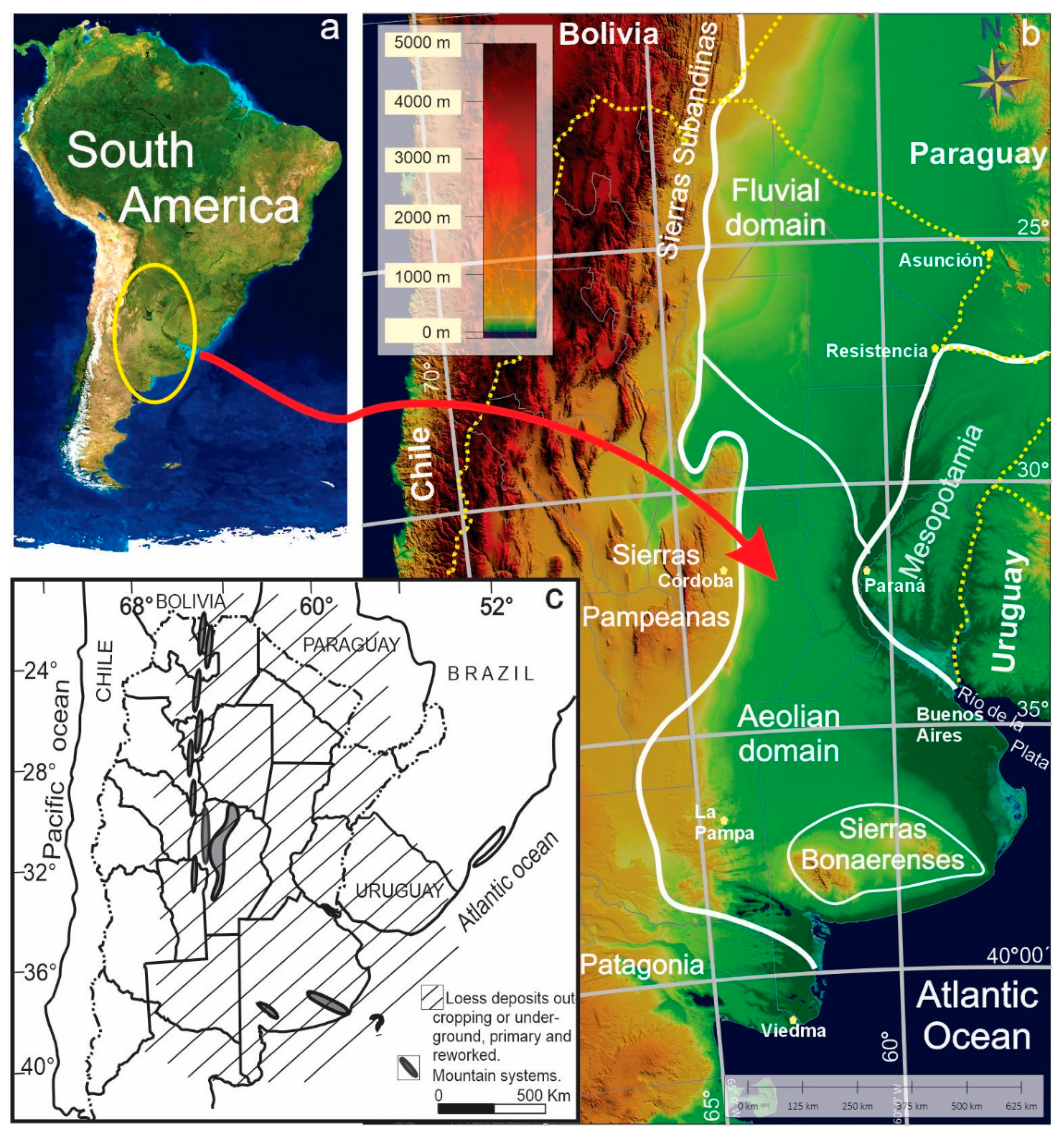
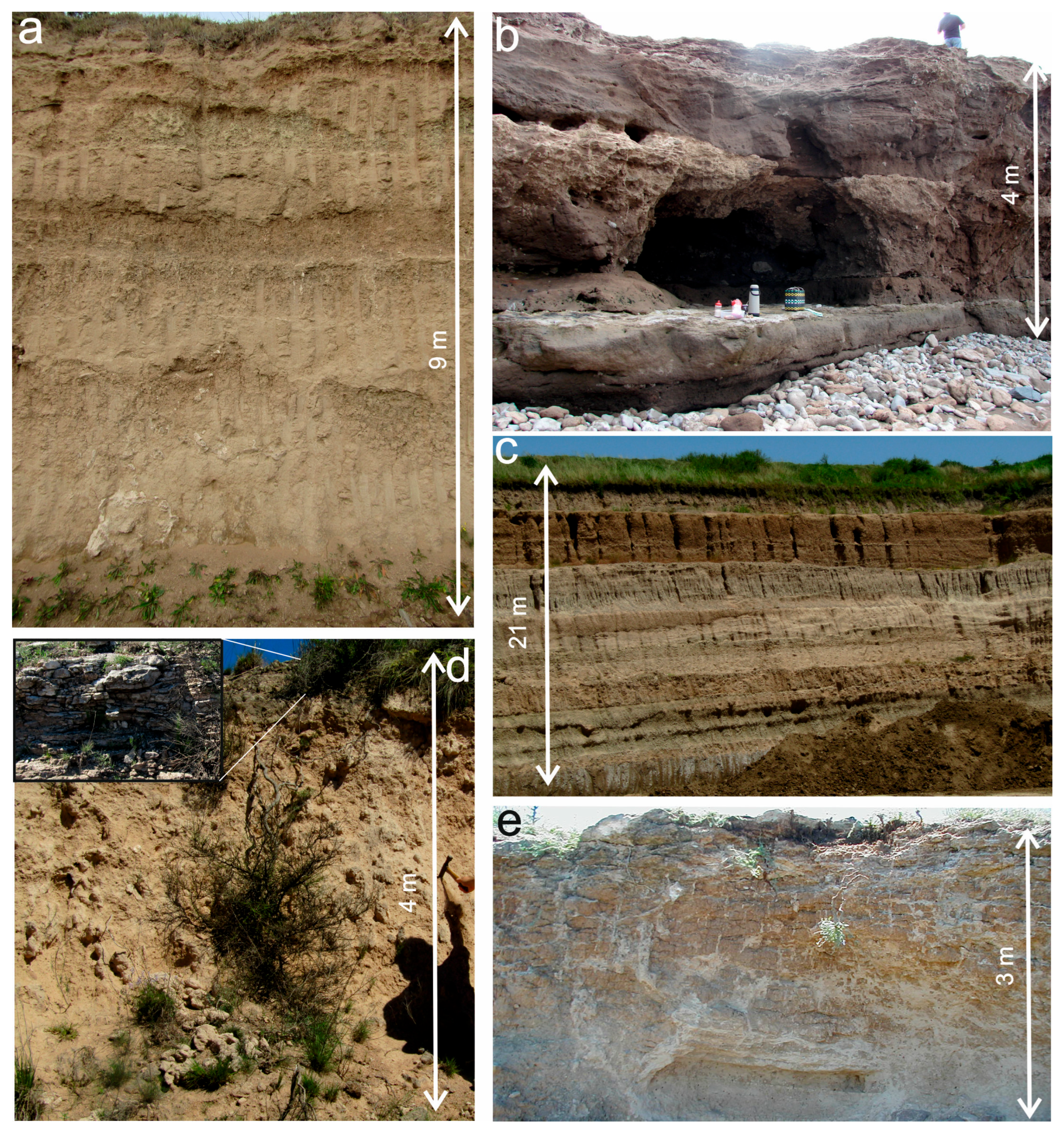


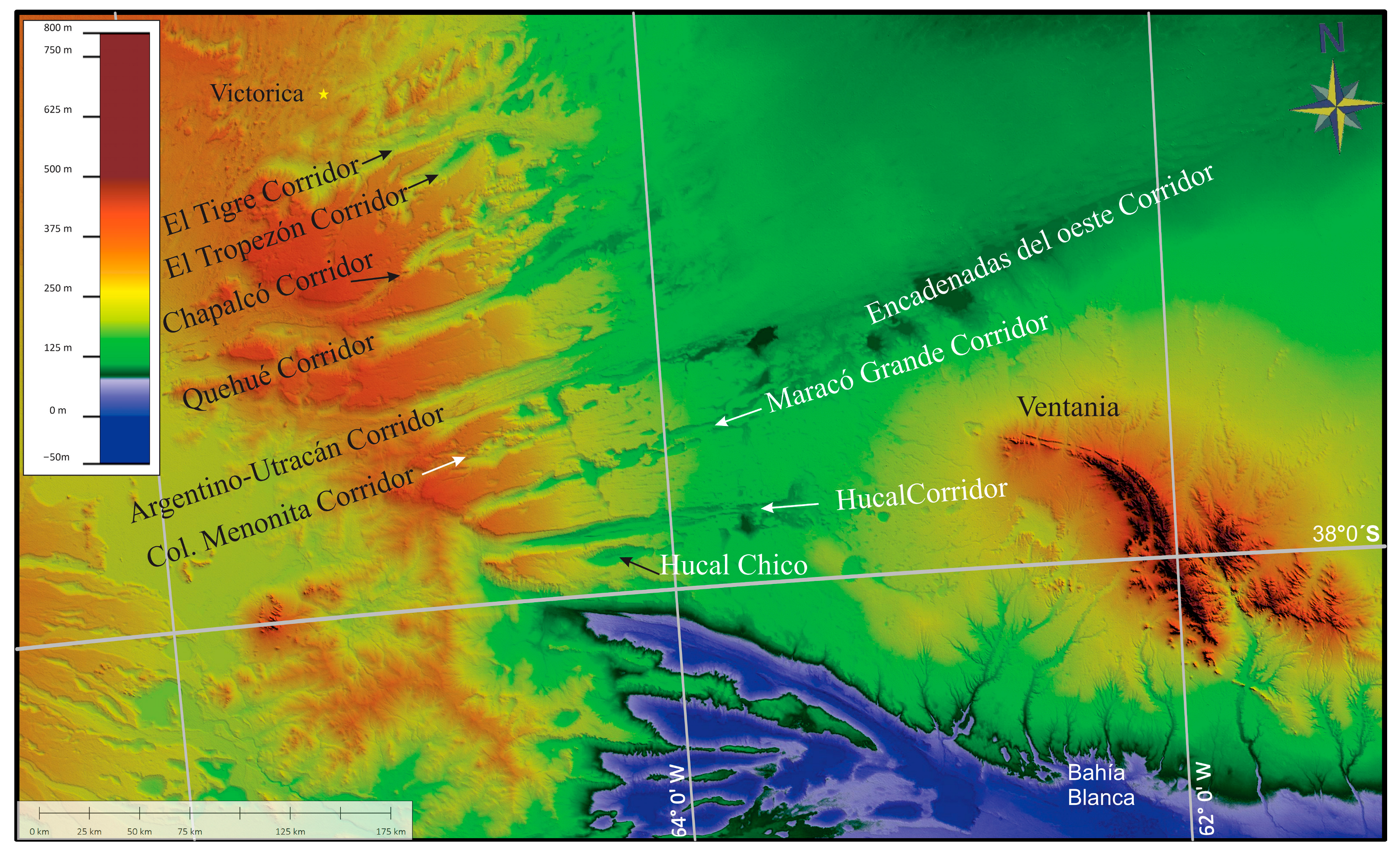
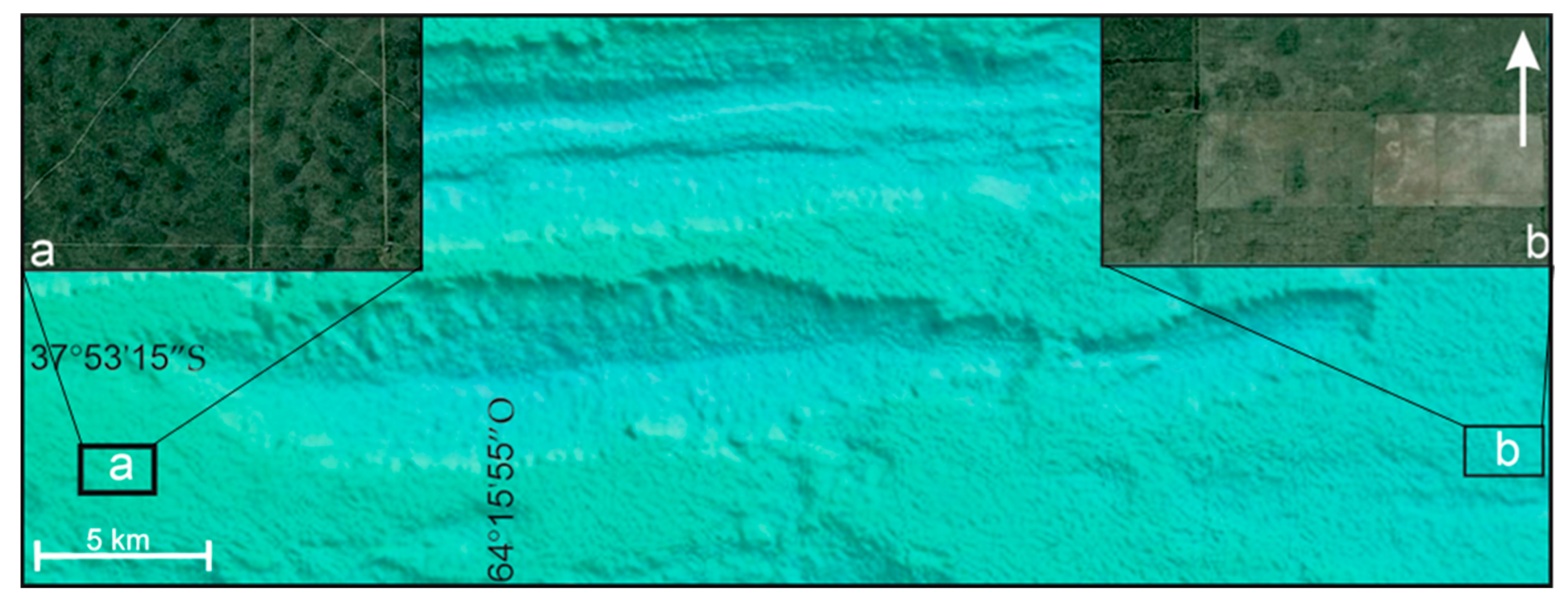
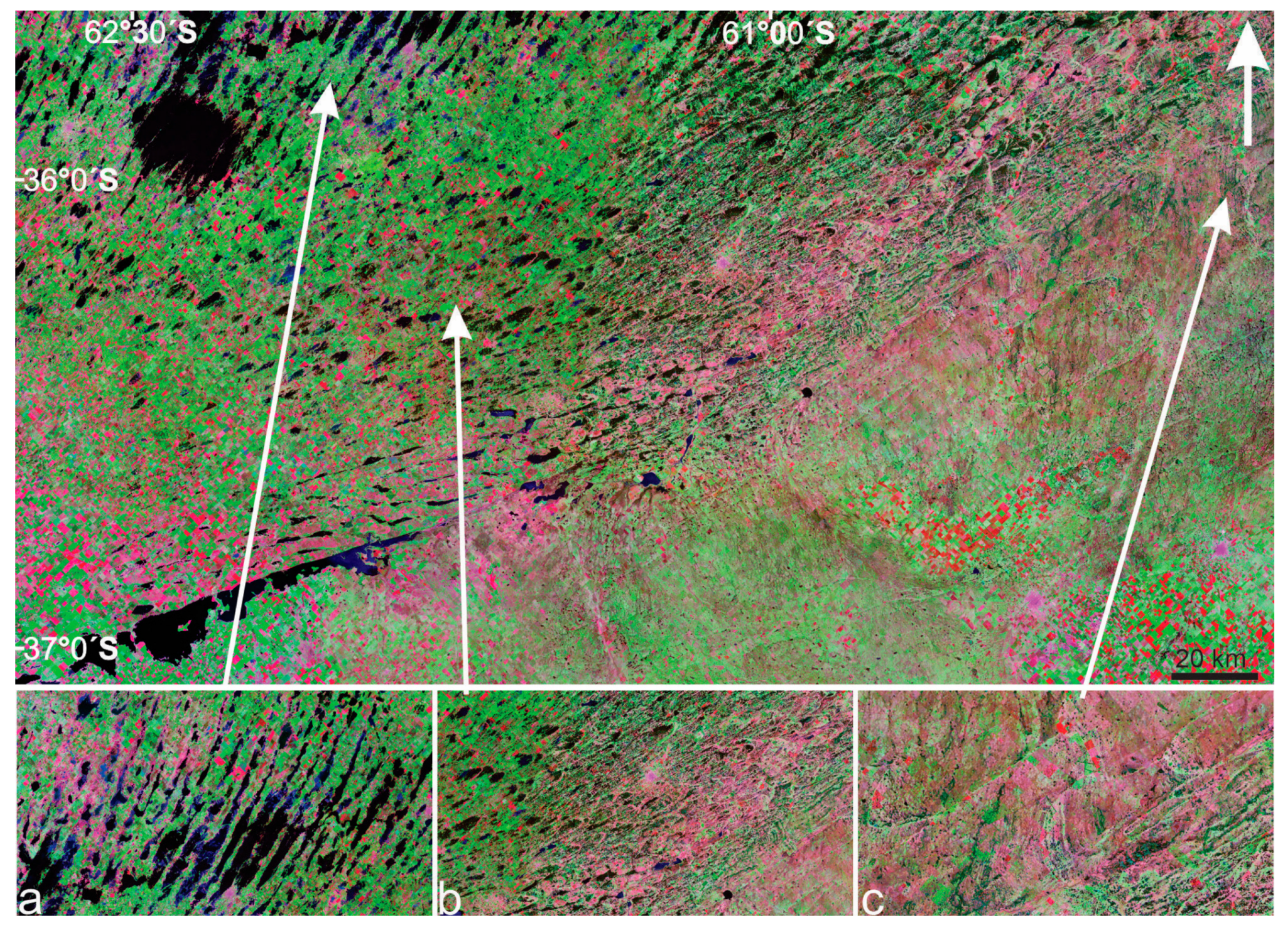


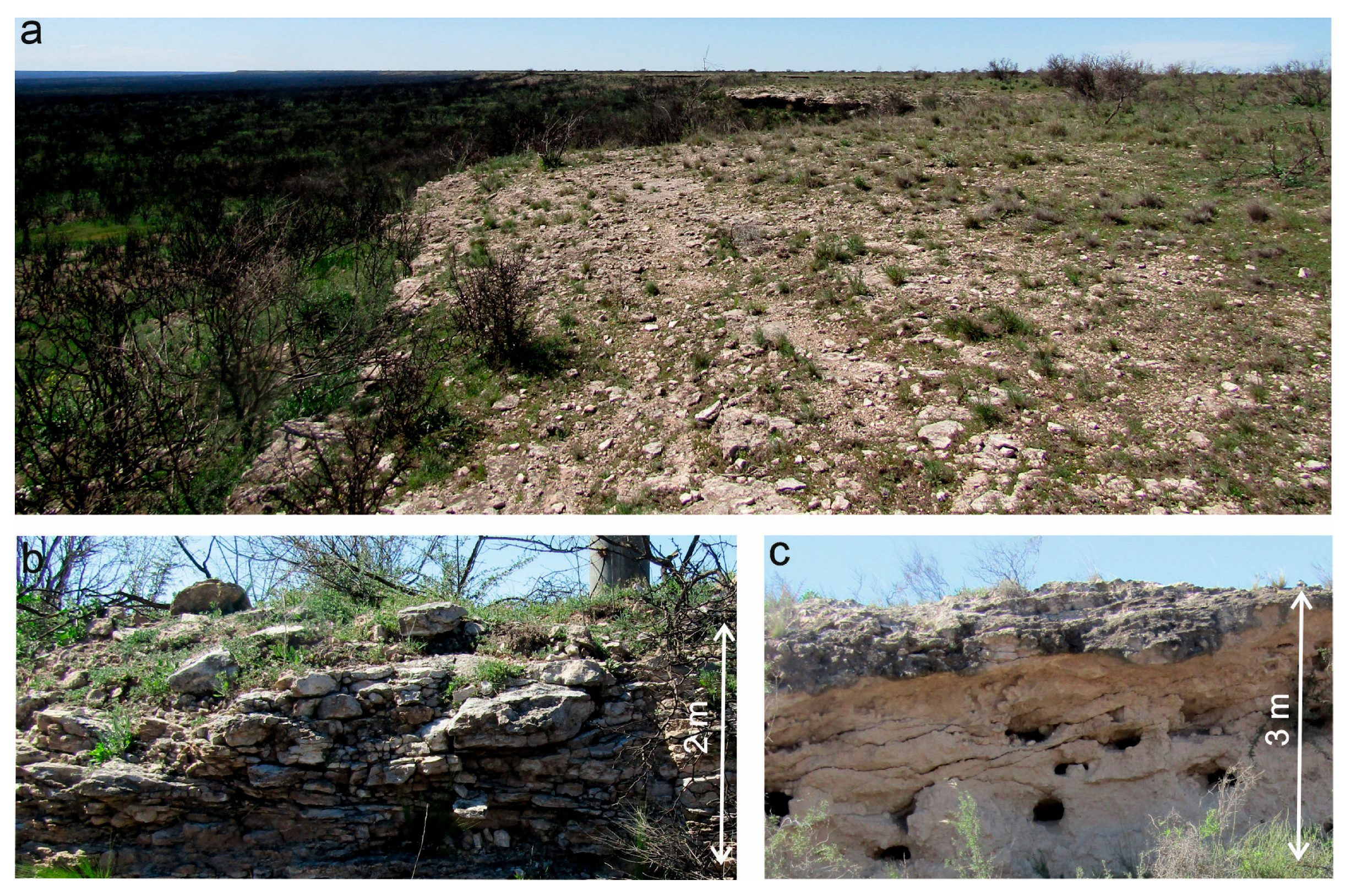
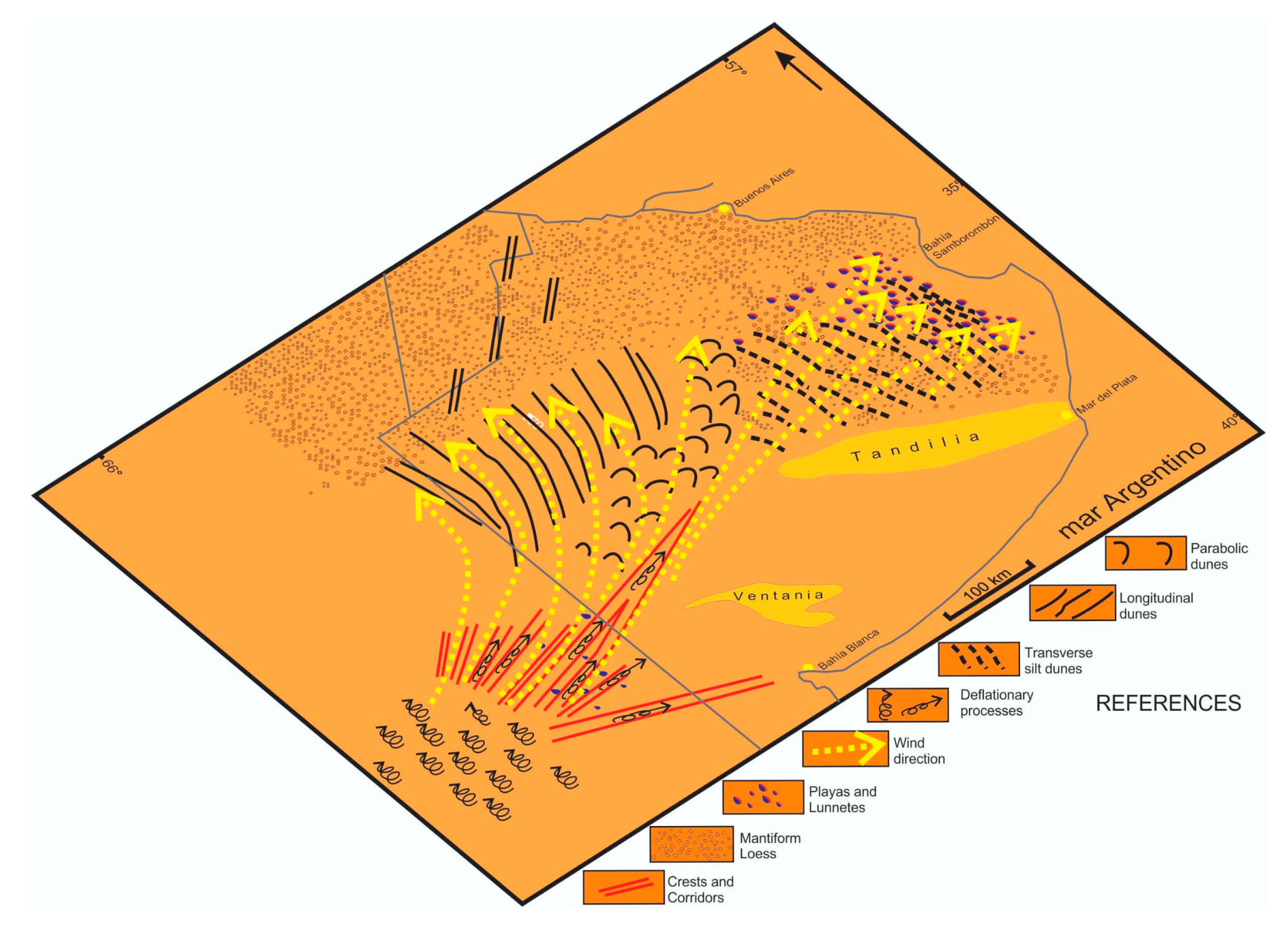
Disclaimer/Publisher’s Note: The statements, opinions and data contained in all publications are solely those of the individual author(s) and contributor(s) and not of MDPI and/or the editor(s). MDPI and/or the editor(s) disclaim responsibility for any injury to people or property resulting from any ideas, methods, instructions or products referred to in the content. |
© 2025 by the authors. Licensee MDPI, Basel, Switzerland. This article is an open access article distributed under the terms and conditions of the Creative Commons Attribution (CC BY) license (https://creativecommons.org/licenses/by/4.0/).
Share and Cite
Fucks, E.; Rico, Y.; Galone, L.; Lorente, M.; D’Amico, S.; Pisano, M.F. Aeolian Landscapes and Paleoclimatic Legacy in the Southern Chacopampean Plain, Argentina. Geographies 2025, 5, 33. https://doi.org/10.3390/geographies5030033
Fucks E, Rico Y, Galone L, Lorente M, D’Amico S, Pisano MF. Aeolian Landscapes and Paleoclimatic Legacy in the Southern Chacopampean Plain, Argentina. Geographies. 2025; 5(3):33. https://doi.org/10.3390/geographies5030033
Chicago/Turabian StyleFucks, Enrique, Yamile Rico, Luciano Galone, Malena Lorente, Sebastiano D’Amico, and María Florencia Pisano. 2025. "Aeolian Landscapes and Paleoclimatic Legacy in the Southern Chacopampean Plain, Argentina" Geographies 5, no. 3: 33. https://doi.org/10.3390/geographies5030033
APA StyleFucks, E., Rico, Y., Galone, L., Lorente, M., D’Amico, S., & Pisano, M. F. (2025). Aeolian Landscapes and Paleoclimatic Legacy in the Southern Chacopampean Plain, Argentina. Geographies, 5(3), 33. https://doi.org/10.3390/geographies5030033






